
|

|
| Use the text links for more information! |
No sidebar menus?, Click Here and re-select |
If you're meeting anyone in town before drinking more beer, a good
meeting place is The
Wellhouse in Cathedral Yard. It is central and never so packed that
you can't move. The booze is pretty good too, normally with a small selection
of guest ales. Food is served at lunchtime, though I've never seen it served
during the evening. The bar is owned by the same people that own the Royal
Clarence Hotel next door.
Royal Clarence
This Hotel was built and established in 1770 having been built by William Praed (an Exeter
Banker) in 1769 on the site of Sir Walter Raliegh's family town house. The main part of the hotel was built as assembly
rooms with the right hand part next to Martin's Lane being Praed's Bank
(Exeter's first Bank, the Exeter Bank).
|
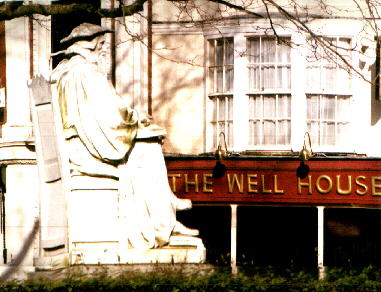 |
|
The first landlord was a frenchman (Pierre Berlon) hence the 'hotel' from the french 'hote'. This was the first hotel in England and used the be referred to simply as The Hotel, and later The Cadogen Hotel. Prior to that the buildings were known as the Assembly Rooms. The Royal Clarence Hotel got its present name from the Dutches of Clarence (later Queen Adelaide, wife of William IV) who stayed on 2 occasions. Nelson received the freedom of the City here after the Battle of the Nile. A sword presented to him can now be seen in the Gallery of the Guildhall. The bank became Dellars Cafe in 1905 and later the hotel's breakfast room. Hotel bars included The Zodiac, (a cocktail bar opening in 1939), which later became Bishops Bar, closing in the mid 1980's. The original Exeter Bank building is now occupied by Michael Caines. A continental style Cafe Bar, owned by the Hotel. |
| The Globe and St Mary Major
Another Hotel once occupied a site on the South Street
side of the War Memorial in Cathedral Yard, this was the Globe Hotel which was
destroyed by incendaries. Click here for an old advert
which also incorporates a line drawing. More information on the Globe
can be found in the Bygone section (select Central).
|
A wall plaque behind the three
gables on the back wall of the South Street shops, states,'beneath this
close the ancient heart of Exeter lie the remains of the Church of St Mary
Major and the Saxon Minster, the Roman Basilica and Military Bath-house
of the 2nd Augustan Legion'. Opposite the Three gables stands St Petrocks Church (for more details turn left at the bottom
of this page) and the 'City Bank', another of Exeter's early banks
opened in 1786.
The Devon County War Memorial of Dartmoor granite was designed by Sir Edwin Lutyens and remembers the fallen of World War 1. The dates shown show the first world war as 1914-1919 as Devon still had troops on the Russian front until 1919. The granite was hewn from Haytor Quarries in one piece. The quarries were re- opened soley for this purpose in 1919 with the memorial finally being erected in 1921. |
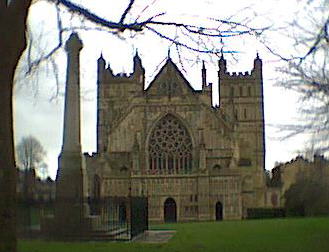 |
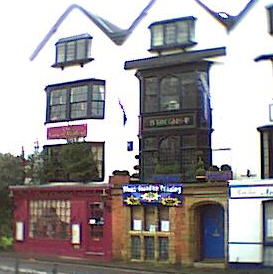 |
| Down the Well
Downstairs via a doorway to the right of the
bar is a stone stairway that'll take you down to a cellar where you can
see the skeleton, a victim of Black Death and also what is left of the well after
which the pub has been named. The remains are in fact those of a tall middle aged man (5ft 9 ins) with
the pelvic bone and arm bones of a woman dating from the same period. Above the case in which the two are laid
is the legend, "Birth is the first step unto death".
The archways in the cellar are from an earlier period than the building itself. During Norman times a
Hall was situated on this site, this was removed in C15th when it was replaced with a tennement. The C17th
saw the addition of the top three floors.
The pub was built on part of the Cathedral graveyard and is an amalgam of two premises, 16 and 17
Cathedral Yard. These buildings as one might expect were either private residences or shops or both.
|
In 1970 Kelly lists R. B Taylor & Son (estate agents) at No.16 and Robert Veitch & Son (seed merchants) next
door at No.17.
The building(s) opened officially as a pub in August 1984 having been bought by the Royal Clarence Hotel next door, though I do remember drinking far too many beers here way before that. Back in the bar area you can sit by the window and look out over Cathedral Yard. A few years ago it was possible to sup on the wall outside but unfortunately this practice has now ended. In the centre of the yard you'll see the Cathedral and Cathedral green, generally heaving with scantilly clad totty during the summer months. An absolute disgrace. |
|
|
|
|
| Cathedral
Exeter became a Cathedral City in 1050 when the Bishop Of Crediton,
Leofric was granted permission by Edward the Confessor
to change the Bishop's
'stool' from Crediton to Exeter. Athelstan's
Church of 932 was burned down by the Danes in 1004.
A further church built by Canute in 1019 became Exeter's first Cathedral and this remained so until
William Warelwast started the Norman Cathedral in 1112. It was dedicated on 21st November 1133,
although not quite finished. Bishop Warelwast, was a nephew of William The Conqueror.
Much of layout you see today was overseen
by a mid 13th century Bishop, Walter Bronescombe, he was succeeded by Bishop
Peter Quivel (or Quinel), who continued with the development of the area,
however despite the early exploits of the aforementioned
Bishops, the cathedral fell into neglect and in the 1870's Sir Gilbert
Scott restored the building and this is mostly what we are able to see
today. The two towers you see are actually named, the north tower
(the one nearest to you) is St Paul's and the other one is St John's. The
stone is Beer Stone.
The North Transept houses a clock, one of only four of it's type
in England. More than 600 years old it shows the earth at its centre with
the moon travelling around it. Just above the clock in the North Tower
hangs a 5.25 ton bell. Peter as its known was procured for the Cathedral
from Llandaff in the 15th century. It was cracked by an over-zealous bell
ringer during a ringing to commemorate the gunpowder plot. For a more detailed
description of the Cathedral why not visit the Cathedral's own website
available through the links page. Click here for a
summary of who did what and when.
|
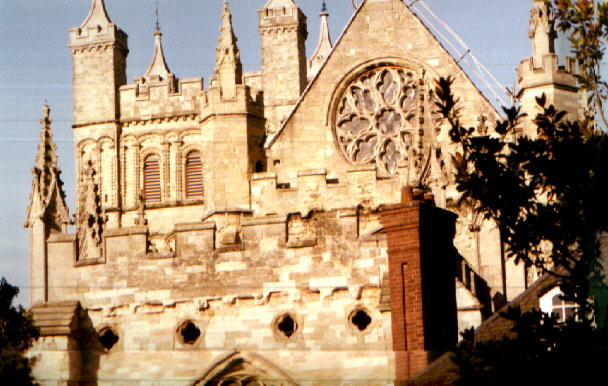 |
| Hooker Richard Hooker's statue is also visible from your seat, he was born in Heavitree in 1554 and wrote Ecclesiastical Polity which might not be a bedtime read but was at the time revolutionary. The Hooker link will tell you more. The statue sits in Cathedral Green which was the most popular burial place for Exonians until 1636. A cemetery in Bartholomew Street was opened in 1637 because of the health hazards caused by the accumulation of corpses and burial mounds. When the memorial in front of the cathedral was erected and the area paved in the late seventies more bone was excavated than soil. |
| Yard and Close
As you leave the Wellhouse, turn
left towards Martin's Lane. On your way you'll see Mol's Coffee House displaying the date "1596".
The building was part of what was a larger building built in 1529 to house the Annuellar Priests. These were a group
of priests who would pray for your soul on the anniversary of your death if they had been left a sum of money to do so.
The reformation put a stop to this practice. In 1549, Mols was subdivided when leased from the Dean & Chapter.
The Dutch gable was added in the late C19th when it was an art gallery. Prior to that it was the residence of
John Glendall, an artist who bought it in 1829. It has also been a jewelers in the past and is now a map specialist.
The Elizabethan frontage is supposed to resemble the
prow of a galleon and was added around 60 years before the place became a Coffee House. The
building became the haunt of both Drake and Raleigh.
When coffee was introduced to England it was opened as a coffee house by
an Italian called Mol and remained popular until 1829.
There are over 230 panes of glass in the windows and none are square.
|
 |
|
Around 1850, Hansons restaurant (next door) which had once been part of the larger Annuelar Priests house was a
Public Library. At the turn of this century, a bootmaker traded here and between WW1 and WW2, it was a hat shop.
The building was converted to a restaurant in the late 1950ís and has been known as Hansons since 1982. In 1992,
the premises were sold by the Church Authorities and are now in privately owned.
A few doors down is No. 5 Cathedral Close, Ask restaurant, the former home of the Exeter and County Club. The building was in fact the former Annuellars College in the C15th. The Exeter and County Club left the building in 1991 having begun in 1871 as The Musgrave Club, moving into the Annuellers College in 1970. The Musgrove club originally inhabited Musgrave house in Musgrave Row, by the City Library. The house was destroyed in 1942. Just to make you choke on your starter, the restaurant is haunted. There is John the Monk and Martha the Nun, their love forbidden tumbled down a well wrappred in each others arms. Lights turn themselves on, burglar alarms go off for no apparent reason, black gowned women walk past open dining hatches, strong smells of perfumes and presences felt. You know, the usual crap. Don't get left alone in the restaurant will you! |
Along the road a little further is No.7 Cathedral Yard is the Devon & Exeter Institute which was set up to
promote the advancement of science literature and the arts, it was once the town house of the Courtenays, the Earls of Devon
who still reside at Powderham Castle, Kenton, on the Dawlish road. The Annuellars Hall remains tucked away behind this C18th
house.
Further on again is the Law Library, which was supposedly the old Chancery of the Cathedral, this is borne out by the existence of the Chacellor's official arms upon it's Tudor doorway. Next is the entrance to the 'Quadrangle' above which appear the arms of Bishop Cotton. There is a great deal of doubt about the origin of this particular building but it seems likely to have belonged to a religeous community. The house standing within it's own gardens in the corner of the Close used to be the residence of the Abbots of Buckfast, later passing into the hands of the Rolle family in 1545. It was retained as a town house by them for about 100 years. On the grey stone wall just before this house is a plaque on the wall marking the former Exeter residence of John Graves Simcoe, who will be better known to Canadians. |
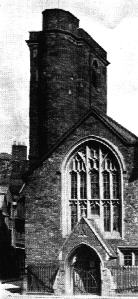 |
Right at the end of the close is an elegant footbridge built in 1814, which was erected over a cut in the City Wall,
by order of Mayor Burnet Patch so that regular inspections of the wall could be made without him having to worry his fat
arse getting off the wall. To see some pictures of this part of the Cathedral Yard, Click Here.
Behind the Cathedral is the Bishop's Palace which you'll see by turning left out of Martin's Lane. However there is a fair probability of a lack of vision by then so click the link for a 'pop up' window. A 'bottomless' hole appeared in this roadway in December 2002, but it has now been made safe. The road is most likely a surviving street from that laid by King Alfred in the C9th as part of his regular grid pattern, the original road finished at the City Wall. Back to where you're standing now (because I don't believe anybody would walk that far to see a foot-bridge), you'll also see St Martin's Church. This church was dedicated in 1065 to St Martin of Tours, the patron saint of drinkers and beggars so you're in good company. Coats of arms that have been aquired over the years suggest that it was a favoured retreat for a number of Bishops of Exeter. 1656 saw the church auctioned for £100 when the commonwealth parliament decided that 13 of Exeter's city churches (which then numbered 17) should be auctioned off. When Charles II was restored to the throne the church went back into diocesean hands and was restored, most likely at the expense of Philip Hooper whose likeness is captured in a wall memorial (opportunist sucker!). |